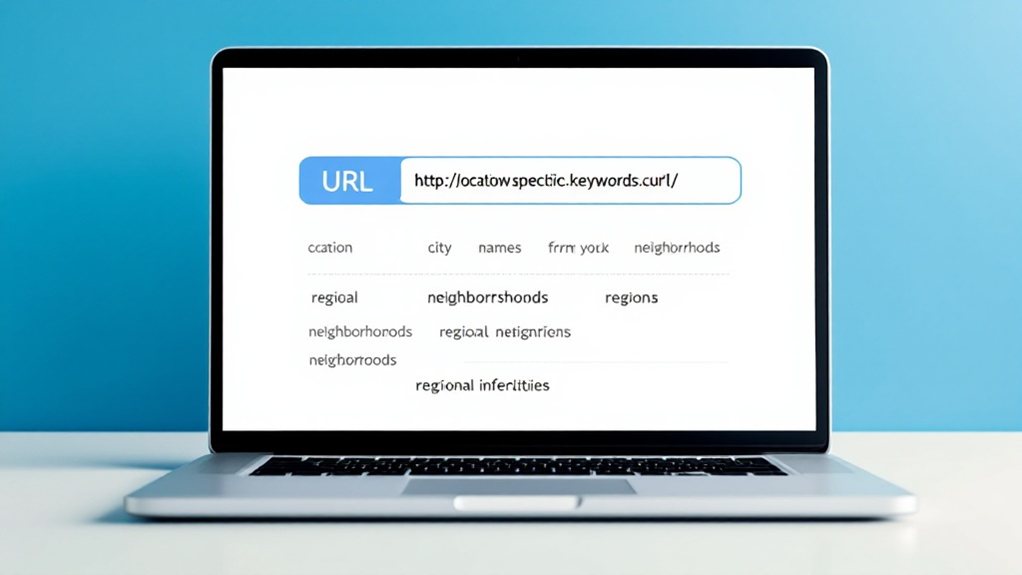To optimize URLs for geo-targeted content, you'll want to craft geographically descriptive URLs that clearly indicate the target location. Incorporate location-specific keywords to enhance local search rankings. Structure your URLs for optimal geo-targeting, using clear hierarchies and hyphens for improved readability. Aligning your URLs with local search intent and utilizing subdirectories for geographic targeting can further boost your visibility. There's more you can learn about customizing URLs for multi-location businesses and implementing geo-specific redirects.
Crafting Geographically Descriptive URLs

When crafting geographically descriptive URLs, it's crucial to organize your URL structure in a logical hierarchy from broader to narrower geographical areas. Ensure the URL is easy for humans to understand and clearly indicates the target location. Maintain a consistent format across similar pages, such as using a 'city-state' format for clarity. Expand geography by including country or region for broader targeting, and organize local service pages by provider details within a location. Prioritize the service type in the URL and adapt the structure based on your existing architecture. Use hyphens, avoid special characters, and keep URLs short and concise for optimal readability and SEO.
Incorporating Location-Specific Keywords in URLs

Optimizing your website's URLs with location-specific keywords is a powerful way to improve local search visibility. Conduct thorough keyword research to identify relevant terms that align with your target audience's search intent. Strategically placing these geo-modifiers in your URLs can signal search engines about the geographic focus of your content, ultimately driving more local traffic to your site.
Identifying Relevant Keywords
Identifying relevant keywords is crucial when it comes to incorporating location-specific terms into your URLs. Location-based search queries often include city or state names, while geographically targeted keywords can help your business appear in local search results. Long-tail keywords offer less competition and higher conversion potential, while neighborhood-specific keywords can target local audiences further. Optimizing your local business listings is also key to improving relevance for local search.
- Location-based search queries include city or state names and specific services.
- Geographically targeted keywords enhance local search engine rankings.
- Long-tail keywords have less competition and higher conversion potential.
- Neighborhood-specific keywords can help target local audiences more effectively.
Strategically Placing Locations
Incorporating location-specific keywords into your website's URLs is a strategic move that can significantly boost your local search visibility. Using subdomains like 'chicago.example.com' for specific locations enhances this further. Organizing content within location-specific directories also improves navigability and SEO. Maintaining consistent use of location keywords in your URLs helps search engines understand your local relevance. Just be mindful of keyword stuffing – use geo-modifiers sparingly to avoid penalties. Ultimately, crafting short, informative URLs that reflect your geographic and thematic structure is key for capturing local audiences and improving your overall search performance.
Structuring URLs for Optimal Geo-Targeting

Crafting readable and intuitive URLs is crucial for geo-targeting. Incorporate location-specific keywords to enhance relevance and user experience. Leverage a hierarchical URL structure to clearly signal geographic focus to search engines. Proper city page optimization is necessary for businesses with multiple locations to rank effectively in local searches.
Readable and Intuitive URLs
Structuring URLs for optimal geo-targeting begins with creating clear, readable patterns. Logical subdirectories like 'your-website.com/uk/products' for UK-specific content enhance geotargeting and simplify the URL structure for both users and search engines. Significant portion of online searches are locally based. Proper use of redirects ensures that users and search engines remain oriented within the geo-targeted structure. Regularly verifying and adjusting URL structures in tools like Google Search Console is beneficial. Following SEO best practices for URL readability, such as using hyphens to separate words, enhances SEO performance.
- Utilize clear, intuitive URL structures to improve visibility in local search results.
- Leverage hreflang tags to signal language and regional variations of URLs to search engines.
- Manage duplicate content issues using canonical tags, preserving link equity across geo-targeted pages.
- Optimize for mobile-friendly and user-friendly URLs to build trust and increase conversion rates.
Keyword Integration for Relevance
With clear, intuitive URL structures in place, the next step in optimizing geo-targeted content involves strategically integrating relevant keywords. Use specific locales like cities or neighborhoods to create targeted key phrases, favoring specific locations for local relevance. Include keyword variations with "near" or "in" for broader search coverage, and combine industry-specific terms with geo-targeted ones for clarity. Embed location-based terms directly in URLs to enhance relevance, but limit keyword usage to 1-2 key terms per URL. Ensure URL keywords align with page content and avoid stop words or special characters that could complicate crawling. Incorporating geo-targeted keywords into the URL structure can further improve the visibility and relevance of the business in local search results.
Hierarchical URL Structure
A hierarchical URL structure is the foundation for effectively optimizing geo-targeted content. This approach helps organize your website's information logically, making it easier for both users and search engines to navigate and understand your content hierarchy. Proper URL structure impacts search engine results page rankings. Some key benefits of a hierarchical URL structure include:
- Clear Content Hierarchy: Organized URLs aid in showcasing your site's structure, enhancing user experience and search engine understanding.
- Improved Visibility: Hierarchical URLs send stronger semantic signals, potentially improving your content's visibility and relevance.
- Localization Clarity: Clear regional or language-specific URL structures can boost your local search presence.
- Enhanced Crawlability: Well-structured URLs assist search engines in efficiently crawling and indexing your website.
Leveraging Hyphens for Improved URL Readability
Consistently using hyphens in your website's URLs can significantly enhance the readability and user-friendliness of your content. Hyphens clearly separate words, making it easier for users to quickly grasp the page's topic. This improves the overall user experience, leading to higher engagement. Additionally, search engines interpret hyphens as word separators, enhancing content understanding and increasing the likelihood of your pages appearing in relevant search results. Hyphens make content more accessible for screen readers and voice assistants. Hyphenated URLs are also more accessible when shared on social media or via email. By adopting a consistent hyphen-based URL structure, you'll create a seamless navigational experience for your audience while aligning with Google's recommended best practices.
Aligning URLS With Local Search Intent
How can you align your website's URLs with local search intent to better attract nearby customers and drive foot traffic? By incorporating location-specific keywords in your URLs, you can signal search engines about the relevance of your content for local searches. Use concise and reader-friendly URL structures, including city names or neighborhoods, to enhance visibility and click-through rates. Additionally, consider:
- Leveraging geo-modifiers in your URLs to improve relevance for location-based queries.
- Ensuring your URLs are short and descriptive, making them easy for users to understand.
- Aligning your URL keywords with the specific needs and attributes of your local audience.
- Optimizing your Google Business Profile to further strengthen your local search presence.
- Regularly updating your URLs to reflect changes in your local market or service offerings.
Optimizing URL Length for Geo-Targeted Content
Optimizing the length of your geo-targeted URLs is paramount to enhance their visibility and appeal in local search results. Keeping URLs under 100 characters is recommended, as longer URLs can get truncated in search engine results, hurting click-through rates. Utilize URL shorteners to minimize length and improve shareability. Aim for short, descriptive URLs that help users understand your content, boosting engagement. Avoid overly complex URLs, as they can hinder crawling efficiency. By optimizing your geo-targeted URL length, you'll create a better user experience and improve your local SEO performance.
Utilizing Subdirectories for Geographic Targeting
Why utilize subdirectories for geographic targeting? Subdirectories offer several benefits, including inheriting the main domain's authority, potentially leading to quicker rankings. They also simplify SEO management and technical changes like hreflang tags.
Some strategies to consider:
- Use clear URL patterns like example.com/canada/products to help Google categorize content.
- Leverage Google Search Console to geo-target each subdirectory path.
- Tailor content to match local preferences, languages, and currencies.
- Monitor performance metrics for each subdirectory to refine your approach.
While subdirectories may lack the precision of subdomains or ccTLDs, they're generally more resource-efficient. By aligning your subdirectory SEO with the main domain, you can achieve cohesive ranking improvements for your geo-targeted content.
Customizing URLs for Multi-Location Businesses
For multi-location businesses, a clear URL hierarchy that incorporates location-specific terms can enhance local search visibility. You'll also want to leverage unique subdomains to target different geographic areas. Optimizing URLs with relevant keywords, without overdoing it, will further improve your online presence across varied locations.
Hierarchical URL Structure
A clear and logical hierarchy in your URL structure is essential for both users and search engines to understand the organization of your content. Maintaining consistency in your URL structure improves SEO and user understanding by providing a uniform approach. Consider incorporating relevant categories in your URLs to aid in local SEO efforts and enhance your site's structure. Your URL paths should clearly indicate the location and service you offer, such as 'www.example.com/services/dentistry/new-york'. Remember, URLs don't always need keywords; sometimes a simple and logical structure is enough.
- Logical Organization
- Consistency
- Categories
- Path Indication
Location-Specific Keywords
Incorporating location-specific keywords into your URLs can significantly boost your multi-location business's online visibility. By including city names or states, you'll help search engines better understand the geographic relevance of your content. Utilize geo-modifiers like "near me" or "downtown" to enhance local search performance. Ensure the location keywords match your page content for improved relevance. Combining service terms with locations targets specific audiences effectively. However, avoid overusing location keywords to maintain content quality. Customized URLs for each location are crucial for expanding your regional presence and boosting local search visibility. Consistent NAP (name, address, phone) across your URLs reinforces your brand identity and contributes to better SEO rankings.
Unique Subdomain Approach
When managing a multi-location business, the unique subdomain approach can be a strategic choice to enhance your online presence. While it requires more resource allocation for setup and maintenance, subdomains allow you to create separate sections of your website that cater to specific areas or target groups. This flexibility enables you to establish distinct branding and content strategies for each location. However, it's important to consider the technical challenges, such as:
- Separate DNS configurations and hosting arrangements for each subdomain
- Search engines treating subdomains as distinct entities, requiring individual SEO efforts
- Potential dilution of domain authority and trust compared to a unified domain
- Higher costs and complexity in maintaining consistency across multiple subdomains
Carefully weighing the advantages and disadvantages of this approach is crucial for effectively leveraging the unique subdomain strategy in your geo-targeted content optimization.
Implementing Geo-Specific URL Redirects
Establishing geo-specific URL redirects is a crucial component of delivering targeted content to users based on their location. Leveraging technologies like geo-IP databases, redirect plugins, and server configurations, you can seamlessly redirect traffic to region-specific pages. Consider the following implementation strategies:
| Redirect Method | Advantages | Disadvantages |
|---|---|---|
| Server Configurations | Granular control, high performance | Requires technical expertise |
| Redirect Plugins | Easy setup, no coding required | Limited customization options |
| Geolocation APIs | Flexible, scalable | Potential for higher costs |
Regardless of the approach, remember to test your redirects thoroughly, maintain your geolocation databases, and optimize your content for search engines to ensure a seamless and effective geo-targeting strategy.
Monitoring and Refining Geo-Targeted URL Strategies
Monitoring your geo-targeted content and URL strategies is key to ensuring they remain effective. Utilize SEO analysis tools, website analytics, and proxy networks to track performance and visibility across different locations. Additionally, leverage local SEO checker tools to verify business listings and accuracy.
- Monitor engagement metrics like bounce rates and time on page to refine your strategies.
- Collect customer feedback to improve relevance and engagement of your geo-targeted content.
- Analyze competitor strategies to stay competitive in the local market.
- Regularly test your website's performance and mobile optimization across various locations.
Continuously optimizing your geo-targeted URLs and content will help you strike the right balance between global and local SEO.
